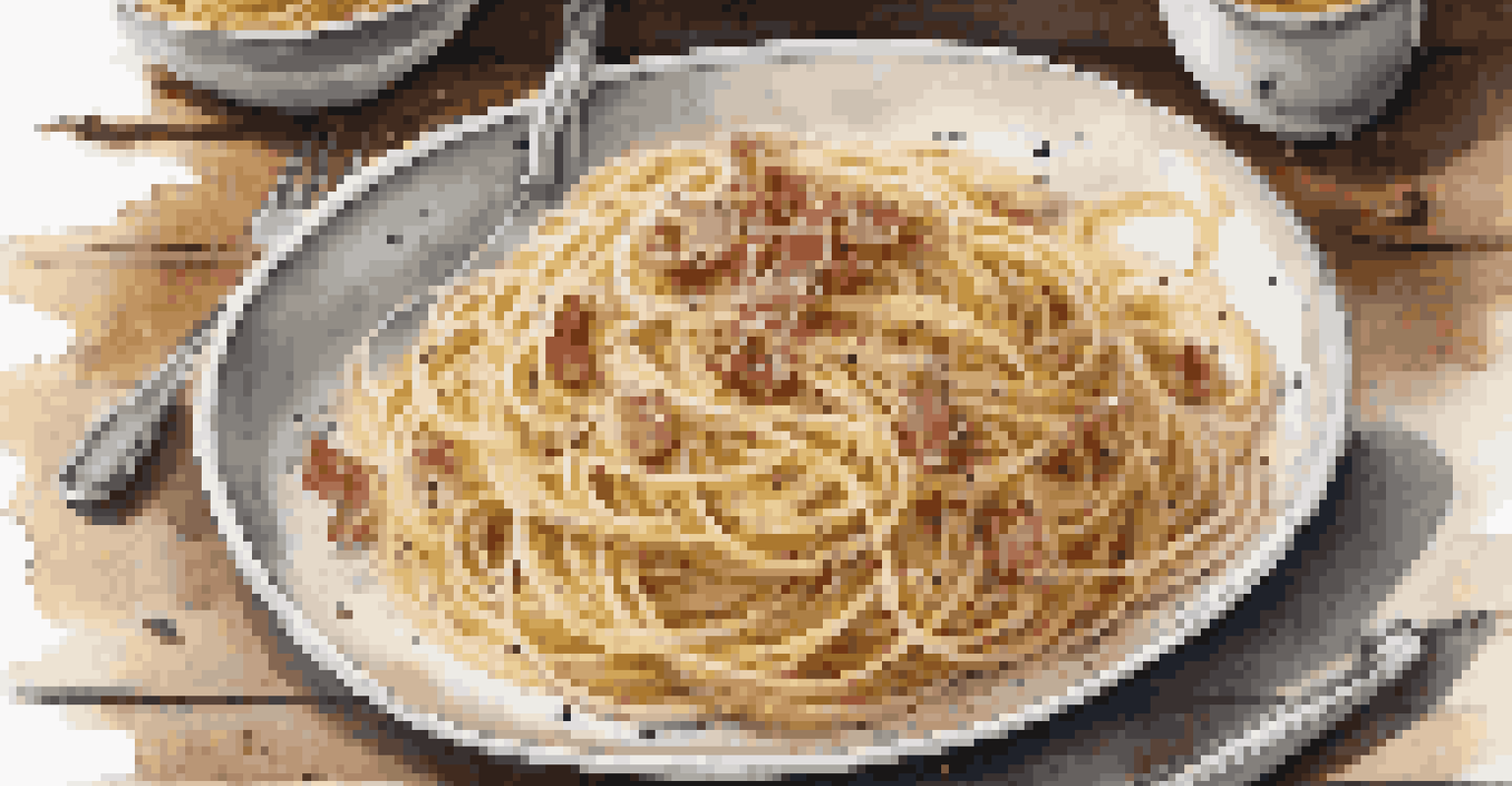Exploring Food History: Recipes with a Story Behind Them

The Ancient Roots of Culinary Traditions
Food has been an essential part of human culture since ancient times. From the early days of hunting and gathering to the development of agriculture, our relationship with food has shaped societies and traditions.
Food is our common ground, a universal experience.
Take bread, for instance. Its origins date back thousands of years, with evidence found in ancient Egypt. As civilizations evolved, so did recipes, often reflecting the available ingredients and cultural influences of the time.
Understanding these historical contexts enriches our appreciation for the dishes we enjoy today, reminding us that each bite carries a narrative that spans generations.
The Story Behind Spaghetti Carbonara
Spaghetti Carbonara is a dish that sparks passionate debates about its origins. Many believe it hails from the Lazio region in Italy, particularly Rome, where it became popular among coal miners, or 'carbonari'.

The dish is a delicious combination of pasta, eggs, cheese, pancetta, and black pepper, but its creation story is equally tantalizing. Some say it was born out of necessity during World War II when American soldiers introduced bacon and eggs to the locals.
Culinary Traditions Reflect History
Many dishes we enjoy today carry narratives that connect us to ancient cultures and practices.
This recipe not only satisfies our taste buds but also serves as a snapshot of history, merging different cultures and circumstances into a beloved Italian classic.
The Cultural Significance of Sushi in Japan
Sushi is more than just a meal; it's a cultural icon with a rich history that dates back centuries. Initially, sushi began as a method of preserving fish using fermented rice, originating in Southeast Asia before evolving into what we know today.
Cooking is like love. It should be entered into with abandon or not at all.
In Japan, sushi became a popular street food in the Edo period, evolving into various forms like nigiri and maki. Each type of sushi tells a story about regional ingredients and culinary techniques.
Today, sushi reflects Japan's dedication to artistry and precision, reminding us that it’s not just about eating, but about an entire experience steeped in tradition.
The Legend of the Caesar Salad
The Caesar Salad, a staple in restaurants worldwide, has a fascinating story behind its creation. It’s said to have been invented by restaurateur Caesar Cardini in Tijuana, Mexico, during the 1920s.
Legend has it that Cardini whipped up the salad with whatever ingredients he had on hand, including romaine lettuce, croutons, and a unique dressing made from garlic, egg, and Parmesan cheese. This spontaneous creation quickly became a hit, drawing crowds across the border.
Culinary Creativity from Necessity
Recipes like Caesar Salad and Spaghetti Carbonara showcase how necessity can inspire innovative culinary creations.
Today, the Caesar Salad stands as a testament to culinary creativity, showcasing how necessity can lead to delicious innovations.
The Renaissance of Traditional Indian Curry
Indian curry is a beloved dish that varies widely from region to region, each with its unique blend of spices and ingredients. Its roots can be traced back to ancient Indian texts, where the use of spices was not just for flavor but also for health.
Each curry tells a story of the local environment—what spices were available, what proteins were commonly consumed, and the cultural practices surrounding food. The diversity found in Indian curry is a reflection of the country’s rich history and multicultural influences.
As global interest in Indian cuisine grows, so too does the appreciation for the stories behind the dishes, reminding us that every bowl of curry is a journey through time and tradition.
The Impact of French Cuisine on Global Cooking
French cuisine is often considered the foundation of modern culinary arts, influencing chefs and home cooks alike around the world. Its techniques and flavor profiles have been integrated into various cuisines, making it a significant part of global food history.
Classic French dishes like Coq au Vin and Ratatouille each have their roots in specific regions, showcasing local ingredients and customs. The stories behind these dishes reveal how food can connect people and cultures across time.
Global Influence of French Cuisine
French cuisine has laid the groundwork for modern cooking, impacting culinary techniques and flavors worldwide.
By exploring French cuisine, we not only learn about cooking techniques but also delve into the cultural narratives that shaped these iconic recipes, highlighting the interconnectedness of food.
The Evolution of Tacos: A Mexican Street Food Staple
Tacos are a quintessential Mexican dish that has transcended borders and become a global favorite. Their origins can be traced back to the indigenous peoples of Mexico, who filled corn tortillas with various ingredients long before European contact.
Over the years, tacos evolved to incorporate different meats, vegetables, and salsas, reflecting regional tastes and cooking methods. Each type of taco tells a story about the area it comes from, whether it’s the fish tacos of Baja California or the al pastor of Mexico City.

Today, tacos are more than just food; they represent a celebration of Mexican heritage, diversity, and the joy of sharing a meal with friends and family.
The Sweet History of Chocolate: From Bean to Bar
Chocolate has a rich and complex history that dates back to ancient Mesoamerica, where it was revered by the Mayans and Aztecs. They consumed it as a bitter drink, often flavored with spices, and used it in various rituals.
The journey of chocolate from its origins to the sweet bars we enjoy today is fascinating. As it spread to Europe in the 16th century, it transformed into a luxurious treat, often sweetened and enjoyed by nobility.
Today, chocolate represents indulgence and comfort, but it also carries a legacy of cultural significance, reminding us of its deep-rooted history and the craftsmanship behind each delicious bite.